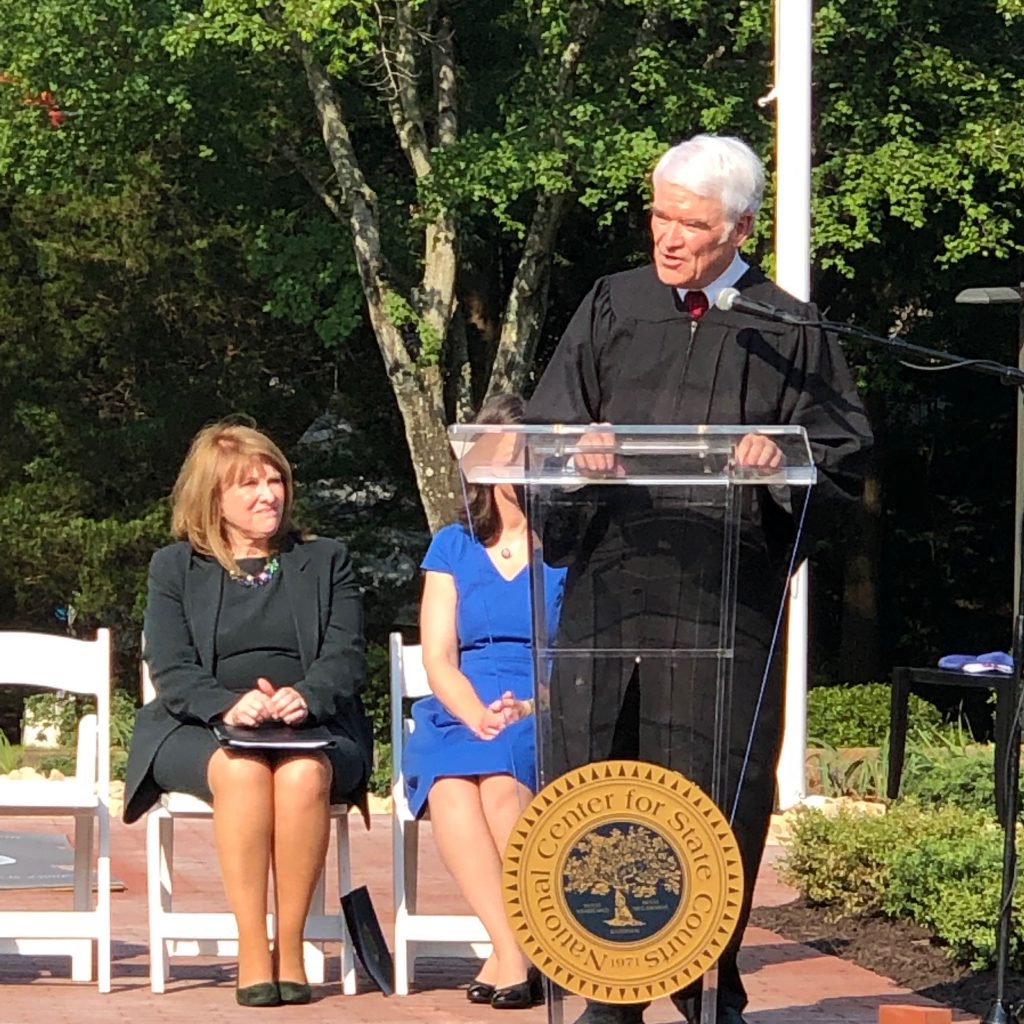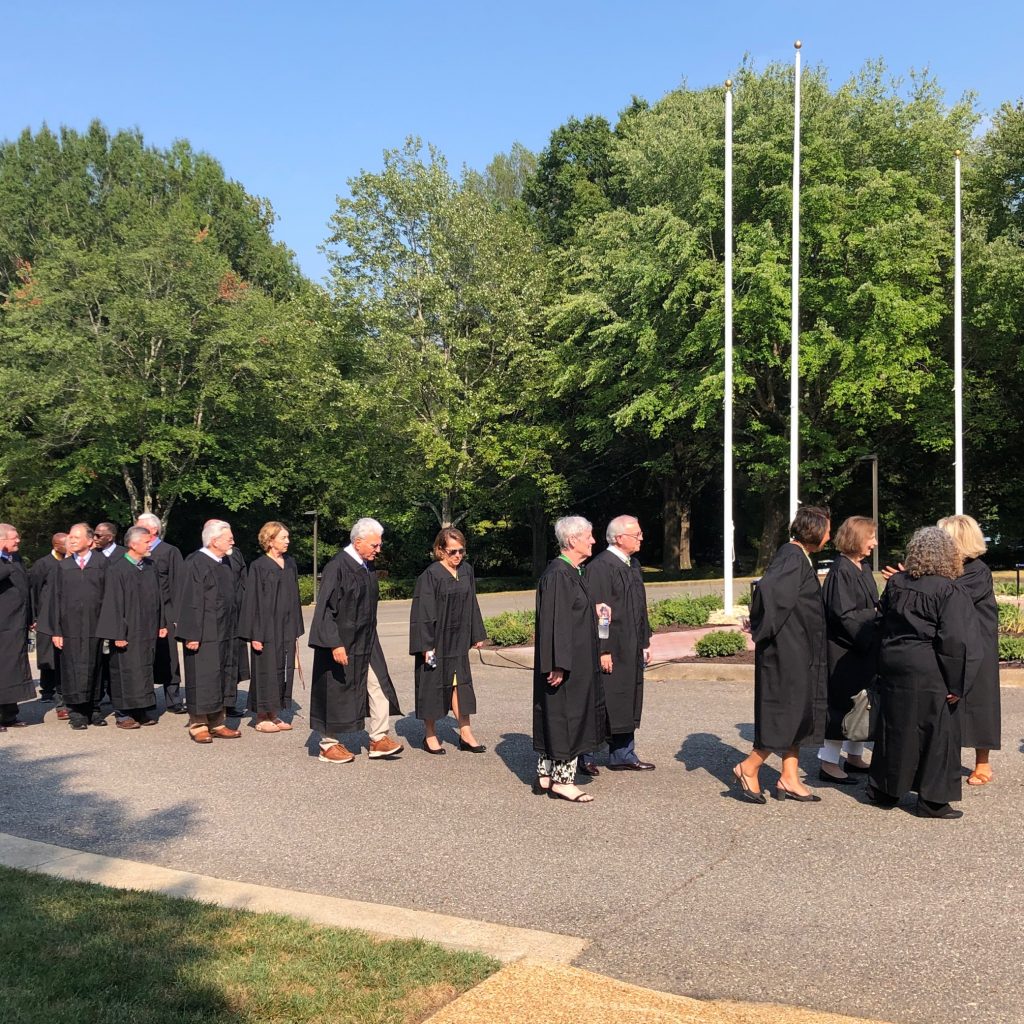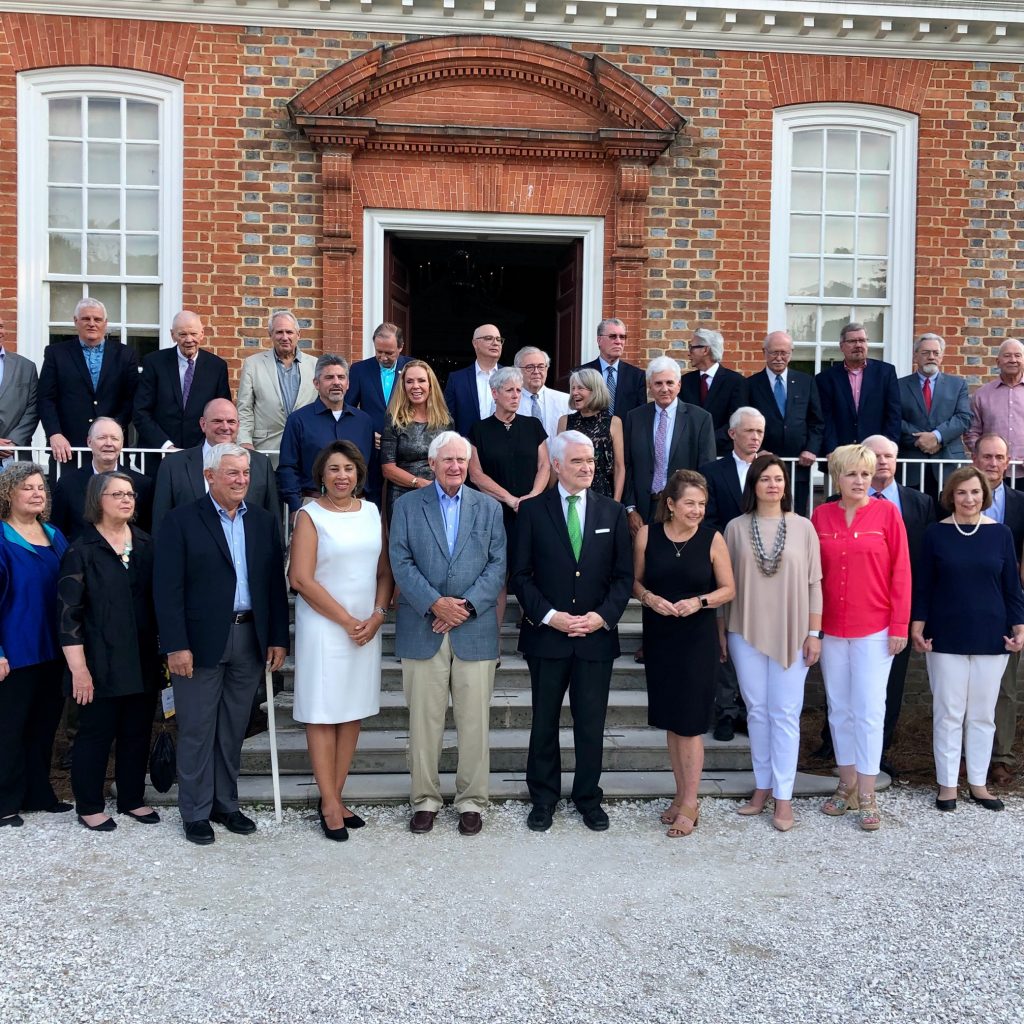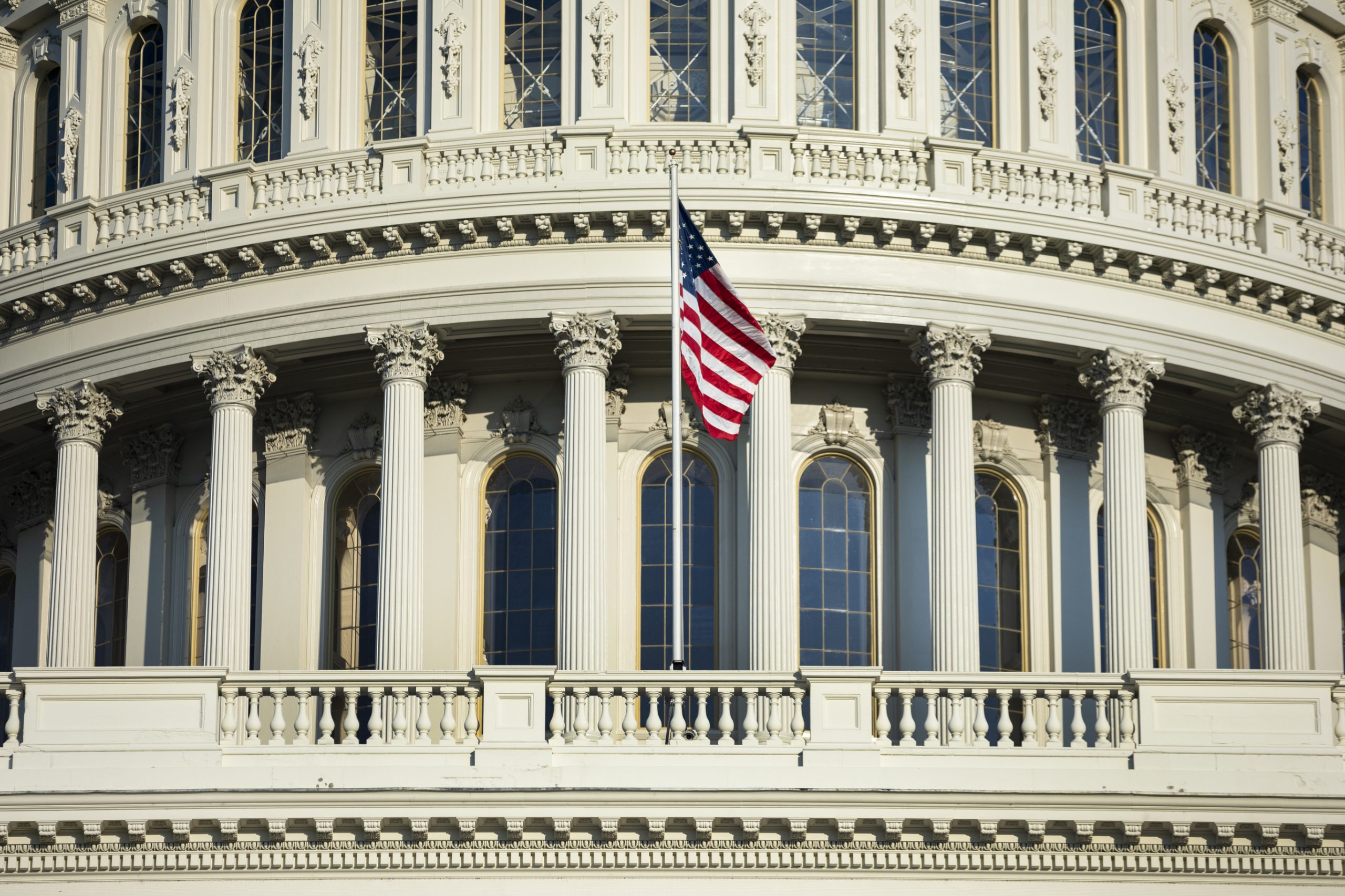The Chief Justices of the supreme courts of the states gathered at the National Center for State Courts at its headquarters in Williamsburg, Virginia. The Chief Justice of the Supreme Court of Texas and Chair of the Conference of Chief Justices and the National Center for State Courts, Nathan L. Hecht, delivered remarks at a celebration celebrating the organization’s 50th anniversary.
The State of State Capitol Security
by Patrick Edwards
The U.S. Capitol riot on Jan. 6 and subsequent threats have inspired a debate over capitol security in statehouses around the country. The events of January 6 are only one example of an already tumultuous year of political violence directed at public buildings and officials. The global pandemic also led to a need for additional security measures to protect against COVID-19. To better understand how these factors have impacted states, analysts with The Council of State Governments (CSG) performed a comprehensive scan of state capitol security across all 50 states and the District of Columbia.
CSG analysts found that significant policy differences exist between states on firearms permissions, security screenings and other security measures. Most capitols restrict the open and concealed carry of firearms and use both metal detectors and X-ray machines. However, seven statehouses permit both open and concealed carry and 13 use neither metal detectors nor X-ray machines.
Findings and Analysis
As of April 27, 2021, 28 state capitols and the Wilson Building (the Washington, D.C. capitol) are closed to the public. Of these 28 state capitols, 24 explicitly state that they are closed to prevent the spread of COVID-19. At the time of this analysis, information was not publicly available for the remaining four closed capitols. However, our analysis indicates that these four capitols are also likely closed due to COVID-19. Finally, the District of Columbia Wilson Building is closed because the city council is not in session. Notably, no state capitols are closed due to threats of violence. This stands in stark contrast to the weeks following Jan. 6 when at least 19 states deployed National Guard troops to their capitols and several shut down statehouse grounds in response to the U.S. Capitol riot.
States also implemented temporary increases in security measures following the U.S. Capitol riot but later removed these as threats of violence failed to materialize. Out of the 10 states that explicitly reported that areas around their capitols were inaccessible in early January, only two — Arizona and Washington — continue to do so. This may be an undercount, as information is not publicly available for 40 states.
Similarly, 10 state capitols explicitly reported that they employed security fencing. Three of these, Minnesota, Oregon and South Carolina, left their fencing installed. As above, this may be an undercount: these 10 states are those that reported setting up and removing their fences.
This indicates that the emphasis of capitol officials has shifted away from threats of political violence and back to the pandemic and traditional security.
34 states and Washington, D.C. prohibit the possession of firearms on capitol grounds, while 16 states permit the possession of personal firearms within their statehouses in some capacity. Citizens can use concealed carry in 14 of the 51 capitols (27%) and open carry in nine capitols (18%). Seven of the 14 capitols that permit concealed carry of firearms also allow open carry. Two states—Louisiana and Nebraska—permit open carry in their capitol complexes but prohibit concealed carry. Louisiana has no law restricting the open carry of firearms within its capitol. But while open carry is technically legal, online sources indicate that entering the capitol while brandishing a firearm will lead to arrest.
Most states prohibit the possession of firearms within their capitols, but a substantial minority do the opposite.
Another significant component of capitol security is the screening process — specifically, the use of metal detectors, X-rays, and required identification (ID).[1] Metal detectors are used to scan people (i.e., walk-through or handheld metal detectors. X-ray machines, however, scan personal items, packages, and the contents of each visitor’s pockets.
Thirty-seven capitols (37%, including the Washington D.C. city building) employ metal detectors at screening checkpoints in building entrances, and a further 31 capitols (61%), employ X-ray machines at entrances to scan all packages and personal items. Of the 18 state capitols that post their ID policy online, 10 required identification to enter their state houses.
Notably, a higher percentage of capitols that permit the open or concealed carry of firearms do not use metal detectors or X-rays compared to states that do not allow personal firearms on capitol grounds. 73% of all capitols use metal detectors, but only 50% of capitols that permit firearms use metal detectors. Similarly, 61% of all capitols use X-ray machines, but only 43% of capitols that allow personal firearms use X-ray machines. This suggests that states which permit personal firearms within their state houses may be less inclined to implement stronger security screening processes.
CSG identified several patterns between the law enforcement agencies that states entrust with protecting their capitol buildings. Twenty-one states delegate capitol security to capitol police divisions, and seven states delegate security to a division of the state’s highway patrol. Interestingly, Massachusetts delegates capitol security to park rangers in the state’s Department of Conservation and Recreation. All other states delegate security to unique subdivisions of each state’s primary police agency.
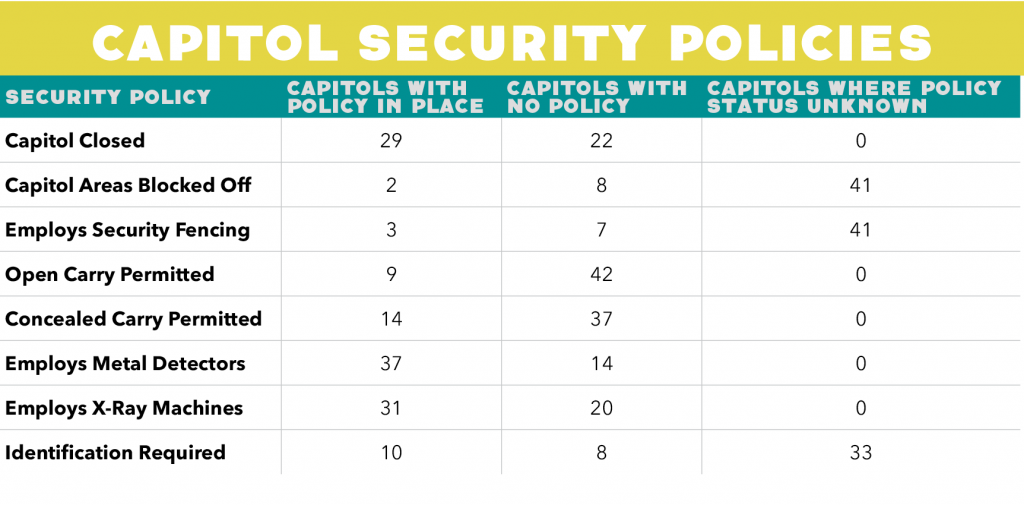
Method of Research
To conduct this research, CSG analysts gathered data from a variety of publicly available sources. Information on state capitol building firearm policy was primarily gathered from the Giffords Law Center’s Database of State Gun Laws and Michigan Advance’s Database of Capitol Building Firearm Policies. Most other data — including information on public access and security screening procedures —were gathered from statehouse websites or local news sources. This is not a comprehensive scan of all capitol security policies as some information is unavailable for most states. In particular, security measures like capitol fencing and ID requirements only reflect information that is publicly available online.
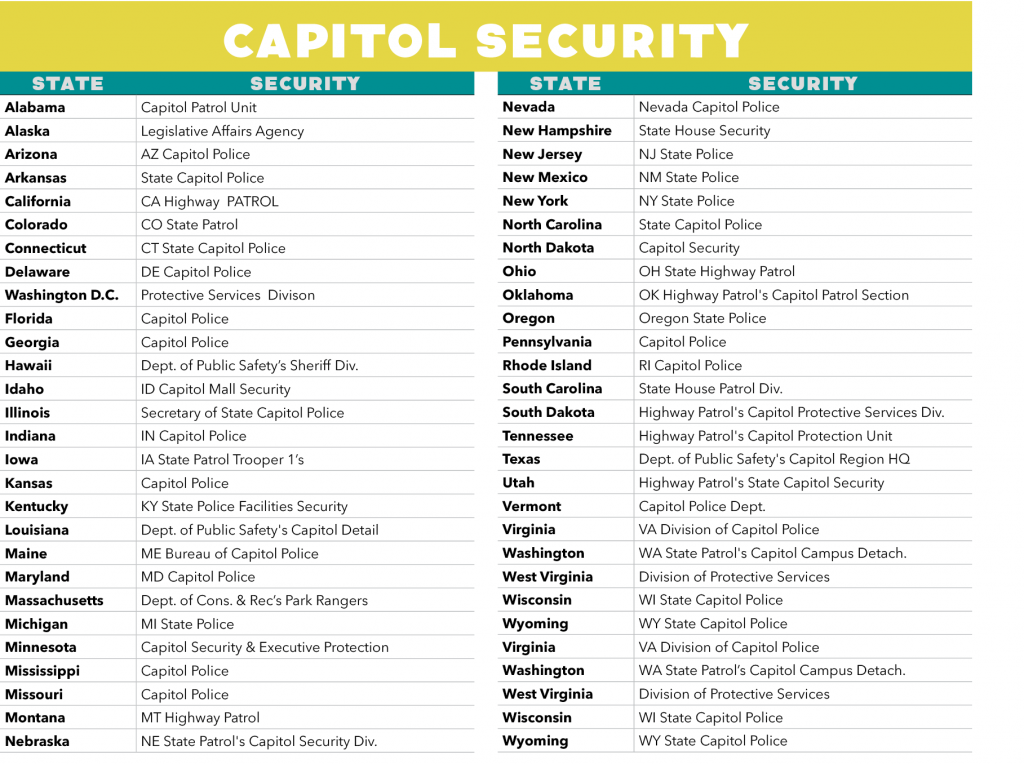




| State | Closed to public | Reason Closed | Areas Blocked | Open Carry | Conceal Carry | Metal Detectors | X-Ray Machines | Security Fencing | ID Required | Security | Date Collected |
|---|---|---|---|---|---|---|---|---|---|---|---|
| Alabama | 0 | N/A | 0 | 0 | 0 | 1 | 1 | ??? | ??? | Capitol Patrol Unit | 4/13/2021 |
| Alaska | 1 | COV-19 | ??? | 0 | 0 | 1 | 0 | 0 | 1 | Security: Legislative Affairs Agency | 4/13/2021 |
| Arizona | 1 | COV-19 | 1 | 0 | 0 | 1 | 1 | 0 | 0 | AZ Capitol Police | 4/15/2021 |
| Arkansas | 1 | COV-19 | 0 | 0 | 0 | 1 | 0 | 0 | 1 | State Capitol Police | 4/14/2021 |
| California | 1 | COV-19 | 0 | 0 | 0 | 1 | 1 | 0 | ??? | CA Highway Patrol | 4/15/2021 |
| Colorado | 0 | N/A | 0 | 0 | 0 | 1 | 1 | 0 | 0 | CO State Patrol | 4/13/2021 |
| Connecticut | 1 | COV-19 | 0 | 0 | 0 | 1 | 1 | ??? | 0 | CT State Capitol Police | 4/15/2021 |
| Delaware | 1 | COV-19 | ??? | 0 | 0 | 1 | 1 | ??? | 1 | DE Capitol Police | 4/15/2021 |
| Washington D.C. | 1 | Not Sess. | ??? | 0 | 0 | 1 | 1 | ??? | ??? | Protective Services Division | 4/15/2021 |
| Florida | 1 | COV-19 | ??? | 0 | 0 | 1 | 1 | ??? | ??? | Capitol Police | 4/15/2021 |
| Georgia | 0 | N/A | ??? | 0 | 0 | 1 | 1 | ??? | 1 | Capitol Police | 4/15/2021 |
| Hawaii | 1 | COV-19 | 0 | 0 | 0 | 0 | 0 | 0 | ??? | Dept. of Public Safety’s Sheriff Div. | 4/15/2021 |
| Idaho | 0 | N/A | 0 | 0 | 0 | 0 | 0 | ??? | ??? | ID Capitol Mall Security | 4/15/2021 |
| Illinois | 1 | COV-19 | ??? | 0 | 0 | 1 | 1 | ??? | ??? | Secretary of State Capitol Police | 4/15/2021 |
| Indiana | 0 | N/A | ??? | 0 | 0 | 1 | 1 | ??? | ??? | IN Capitol Police | 4/15/2021 |
| Iowa | 0 | N/A | ??? | 0 | 1 | 1 | 1 | ??? | ??? | IA State Patrol Trooper 1’s | 4/26/2021 |
| Kansas | 1 | COV-19 | ??? | 0 | 1 | 1 | 1 | ??? | 1 | Capitol Police | 4/20/2021 |
| Kentucky | 1 | COV-19 | ??? | 1 | 1 | 1 | 0 | ??? | 1 | KY State Police Facilities Security | 4/20/2021 |
| Louisiana | 0 | N/A | ??? | 1 | 0 | 1 | 1 | ??? | ??? | Dept. of Public Safety’s Capitol Detail | 4/20/2021 |
| Maine | 1 | COV-19 | ??? | 0 | 0 | 1 | 1 | ??? | ??? | ME Bureau of Capitol Police | 4/21/2021 |
| Maryland | 1 | COV-19 | ??? | 0 | 0 | 1 | 1 | ??? | 1 | MD Capitol Police | 4/21/2021 |
| Massachusetts | 1 | ??? | ??? | 0 | 0 | 1 | 0 | ??? | 0 | Dept. of Cons. & Rec’s Park Rangers | 4/20/2021 |
| Michigan | 0 | N/A | ??? | 0 | 0 | 0 | 0 | ??? | ??? | MI State Police | 4/20/2021 |
| Minnesota | 1 | ??? | ??? | 0 | 1 | 0 | 0 | 1 | ??? | Capitol Security & Executive Protection | 4/26/2021 |
| Mississippi | 0 | N/A | ??? | 0 | 0 | 1 | 1 | ??? | ??? | Capitol Police | 4/21/2021 |
| Missouri | 0 | N/A | ??? | 0 | 1 | 1 | 1 | ??? | 0 | Capitol Police | 4/21/2021 |
| Montana | 0 | N/A | ??? | 0 | 1 | 0 | 0 | ??? | ??? | MT Highway Patrol | 4/21.2021 |
| Nebraska | 0 | N/A | ??? | 1 | 0 | 0 | 0 | ??? | ??? | NE State Patrol’s Capitol Security Div. | 4/21/2021 |
| Nevada | 1 | COV-19 | ??? | 0 | 0 | 1 | 1 | ??? | ??? | Nevada Capitol Police | 4/21/2021 |
| New Hampshire | 0 | N/A | ??? | 1 | 1 | 0 | 0 | ??? | ??? | State House Security | 4/22/2021 |
| New Jersey | 1 | COV-19 | ??? | 0 | 0 | 1 | 1 | ??? | 1 | NJ State Police | 4/22/2021 |
| New Mexico | 1 | COV-19 | 0 | 1 | 1 | 0 | 0 | 0 | ??? | NM State Police | 4/22/2021 |
| New York | 1 | COV-19 | ??? | 0 | 0 | 1 | 1 | ??? | 1 | NY State Police | 4/22/2021 |
| North Carolina | 1 | COV-19 | ??? | 0 | 0 | 1 | 1 | ??? | ??? | State Capitol Police | 4/22/2021 |
| North Dakota | 0 | N/A | ??? | 0 | 0 | 1 | 1 | ??? | 0 | Capitol Security | 4/22/2021 |
| Ohio | 1 | N/A | ??? | 0 | 0 | 1 | 1 | ??? | 0 | OH State Highway Patrol | 4/22/2021 |
| Oklahoma | 0 | N/A | ??? | 0 | 0 | 1 | 1 | ??? | ??? | OK Highway Patrol’s Capitol Patrol Section | 4/23/2021 |
| Oregon | 1 | COV-19 | ??? | 1 | 1 | 0 | 0 | 1 | ??? | Oregon State Police | 4/23/2021 |
| Pennsylvania | 0 | N/A | ??? | 0 | 0 | 1 | 1 | ??? | ??? | Capitol Police | 4/22/2021 |
| Rhode Island | 1 | COV-19 | ??? | 0 | 1 | 1 | 1 | ??? | ??? | RI Capitol Police | 4/23/2021 |
| South Carolina | 0 | N/A | ??? | 0 | 0 | 1 | 0 | 1 | ??? | State House Patrol Div. | 4/23/2021 |
| South Dakota | 0 | ??? | ??? | 0 | 1 | 1 | 1 | ??? | 0 | Highway Patrol’s Capitol Protective Services Div. | 4/23/2021 |
| Tennessee | 0 | N/A | ??? | 0 | 0 | 1 | 1 | ??? | 1 | Highway Patrol’s Capitol Protection Unit | 4/23/2021 |
| Texas | 0 | N/A | ??? | 1 | 1 | 1 | 1 | ??? | ??? | Dept. of Public Safety’s Capitol Region HQ | 4/23/2021 |
| Utah | 0 | N/A | ??? | 1 | 1 | 0 | 0 | ??? | ??? | Highway Patrol’s State Capitol Security | 4/23/2021 |
| Vermont | 1 | COV-19 | ??? | 0 | 0 | 0 | 0 | ??? | ??? | Capitol Police Dept. | 4/23/2021 |
| Virginia | 1 | ??? | ??? | 0 | 0 | 1 | 0 | ??? | ??? | VA Division of Capitol Police | 4/23/2021 |
| Washington | 1 | COV-19 | 1 | 1 | 1 | 0 | 0 | ??? | ??? | WA State Patrol’s Capitol Campus Detach. | 4/23/2021 |
| West Virginia | 1 | COV-19 | ??? | 0 | 0 | 1 | 1 | ??? | ??? | Division of Protective Services | 4/23/2021 |
| Wisconsin | 1 | COV-19 | ??? | 0 | 0 | 0 | 0 | ??? | ??? | WI State Capitol Police | 4/26/2021 |
| Wyoming | 0 | N/A | ??? | 0 | 0 | 0 | 0 | ??? | ??? | WY State Capitol Police | 4/27/2021 |
CSG Mourns the Loss of Former Eastern Regional Conference Director Alan Sokolow
“Alan’s leadership guided state officials through many challenges and empowered them to govern better. While his expertise was substantial, it was his love of people and public service that helped him forge so many lasting and valued partnerships and friendships. CSG, the states and our nation are all stronger because of Alan’s work.”
— CSG Executive Director/CEO David Adkins
Former director of The Council of State Governments Eastern Regional Conference, Alan V. Sokolow, passed away on July 23. Sokolow joined the CSG eastern office in 1967 as a field representative. In 1972, he was promoted to director where he served until his retirement in 2009.
“Alan’s career at The Council of State Governments spanned four decades. His leadership guided state officials through many challenges and empowered them to govern better,” said CSG Executive Director/CEO David Adkins. “While his expertise was substantial, it was his love of people and public service that helped him forge so many lasting and valued partnerships and friendships.
“CSG, the states and our nation are all stronger because of Alan’s work. He lives on in his beloved family and in all the good he achieved. May his memory be a blessing.”
In 2008, a resolution was passed in the Rhode Island General Assembly honoring Sokolow and celebrating his retirement from CSG. The resolution stated, “Rhode Island and the states of the eastern region have been the beneficiaries of the wisdom, integrity and abiding dedication to excellence that Alan Sokolow has always brought to his work at CSG, and along the way, he has earned the unqualified admiration and respect of his fellow workers as well as state officials.”
A dedicated Brooklyn Dodgers and Mets fan, Sokolow was involved in political campaigns and an active member of Temple Ner Tamid in Bloomfield, New Jersey. He is survived by his wife of 53 years, Margo, two daughters, Rachel and Elena, and two grandchildren, Max and Leo.
Paralympian and Legislator Will Watch, Attend Paralympic Games

While the whole world will be watching the Olympics beginning on July 23, one state legislator has a particular interest in the Olympic and Paralympic games.
“I never miss an Olympic game when they are on,” said Idaho state Rep. Muffy Davis. “I am glued to it. I love watching athletes strive to be their best and the stories they tell.”
Davis, who will be traveling to Tokyo as a member of the United States Olympic and Paralympic Committee board of directors, a position she was appointed to after years of competing and medaling in the Paralympic Games.
Davis won a bronze medal in Slalom in the 1998 Olympics in Japan and in 2002, she won three silver medals in the downhill, super-G and giant Slalom events. In 2012, she won three gold medals in handcycling events in the London Paralympic Games.
She had been a top prospect for Olympian skiing before she had a skiing accident in 1989 that left her paralyzed. Davis had to take time to re-learn how to ski and learn other sports to accommodate her disability. The Council of State Governments profiled her as part of our 2020 special issue of Capitol Ideas Magzine, “30 Years of the American With Disabilities Act.”
“The hardest part of my accident and becoming disabled was thinking my lifelong dream and goal was over — that I wouldn’t be able to accomplish it,” said Davis, who was injured at 25. Soon, however, she learned about Paralympics movement, which gave her dream new life.
‘My injury level was quite high,” Davis said. “In my mind, I was a ski racer, so I was going to jump on a Monoski and be great right away. That didn’t work quite that way. It was very hard. It took a long time. Being tenacious or stubborn, I didn’t quit or give up, and I knew that it was possible. For me, I had to mentally and emotionally think of it as a new sport because it was so painful to try and think of it as skiing, as I had.”
Davis credits her family and coaches for their support and help in connecting her with the right resources to learn how to ski differently and try other sports.
Davis became a member of the Idaho House of Representatives in 2018 and is passionate about the issues of education and healthcare.
As a member of the United States Olympic and Paralympic Committee board of directors, Davis will travel to watch some of the Paralympic Games before coming back for some legislative duties.
“We just finished […] the U.S. Paracycling National Championships, and they were hosted here in Boise, Idaho,” she said. “It was so cool to come and hand out medals. Some of our female hand cyclists are some of the top in the world. It would be my dream to hand out a Paralympic medal to some of our U.S. athletes who I helped mentor. It is an honor to give it to any athlete, but it’s so fun to give it one of our own countrymen or women.”
Associates in Action: Target Announces Target Forward, a Green Sustainability Strategy
by Julianne Stahl
In June, Target Corporation, a CSG Associate, unveiled Target Forward, a new sustainability strategy that is focused on restoring and regrowing natural systems to positively impact the planet. Target aims to co-create an equitable and regenerative future with its guests, partners and communities.
The commitments Target is making with Target Forward work towards three critical ambitions: to design and elevate sustainable brands, to innovate to eliminate waste and to accelerate opportunity and equity. Signature goals of this initiative include:
- By 2030, Target strives to be the market leader for creating and curating inclusive, sustainable brands and experiences.
- By 2040, Target plans for 100% of its owned brand products to be designed for a circular future. Target’s teams will continue designing to eliminate waste, using materials that are regenerative, recycled or sourced sustainably, to create products that are more durable, easily repaired or recyclable. Target accelerated its commitments to sustainable packaging in 2018 when it became a signatory to the New Plastics Economy Global Commitment.
- By 2040, Target commits to being a net zero enterprise — zero waste to landfill in its U.S. operations and net zero emissions across both its operations and supply chain.
Target’s efforts in collaborating to bring equitable, viable solutions for its communities and the environment is being built on a preexisting foundation of sustainability. In 2019, the company set science-based targets for reduction in its emissions from its facilities, emissions from energy purchased to power its facilities and emissions from the entire supply chain. Target also committed to join the “Business Ambition for 1.5°C,” ensuring that its emissions will contribute to no more than 1.5 degree warming. Target also has projects and partnerships in place that when complete, will result in purchasing nearly 50% of its electricity from renewable sources, on its way to 100% by 2030.
“As a company and a member of the global community, it’s imperative for both the health of our business and of our planet that we embrace new ways to move forward,” said Brian Cornell, chairman and chief executive officer of Target. “We know sustainability is tied to business resiliency and growth, and that our size and scale can drive change that is good for all. Target Forward influences every corner of our business, deepens our collaboration with our partners and builds on our past efforts to ensure a better future for generations to come.”
To learn more about Target Forward visit Target.com/targetforward.
Associates in Action articles highlight CSG Associates’ philanthropic efforts and public-private partnerships throughout the states.
Initial Bipartisan Infrastructure Bill Hits Early Snags
The Biden Administration announced a June 24 agreement on a bipartisan, $1.2 trillion infrastructure package (including $550 in new spending) negotiated by a group of 21 Republican and Democratic senators.
However, shortly after the meeting and announcement, the deal began to fall apart. President Biden said later that same day that he would not sign the bipartisan package unless it was accompanied to his desk by a multi-trillion-dollar package of investments — in family services, climate change and other initiatives — passed through the budget reconciliation process (that requires 51 votes rather than the 60 normally required to end a filibuster and vote). The outlines of the broader bill reflect many of the support services initiatives in the Biden Administration’s original infrastructure proposal, as well as the American Family Plan.
This insistence was later echoed by Speaker Nancy Pelosi, further challenging continued support of the bipartisan agreement.
By Friday, June 25, several of the 11 Republicans who supported the deal on Thursday were announcing their withdrawal because they did not favor twinning the bipartisan package with the larger effort maneuvered through reconciliation.
By the next day, the Biden Administration had reversed course, decoupling the two efforts, which was a walk-back that seems to have worked.
During the last week of June, the Biden Administration commenced its advocacy for the bipartisan infrastructure legislation, but the House of Representatives passed a $715 billion counter proposal in the same window, largely along party lines.
More about the differences in the two proposals from The New York Times:
Just how the House Democratic vision of infrastructure will be melded with the deal struck by five Republicans and five Democrats in the Senate is anything but clear. The House bill and the Senate deal are not far apart in spending numbers on traditional infrastructure. Both efforts take up Mr. Biden’s call to replace all of the country’s lead drinking water pipes.
But while the Senate framework only lays down broad categories of spending, the House bill extends surface transportation policies and user funds that are set to expire Oct. 1. It also established new policies like water bill assistance, buy American requirements and a pilot program for low-income transit access.
So, what happens now? While a bipartisan deal has been reached, it appears an agreement is still a way down the road.
A potential timeline:
- During the congressional recess, relevant committee chairs and others will take the scaffolding of the bipartisan package and put it into legislation form. The Senate will vote — leadership hopes by the end of July — and after some legislative back and forth, negotiators will attempt to reconcile the Senate agreement with the bill the House has passed.
- On the reconciliation track, first there must be a Budget Resolution laying out the broad parameters of the multi-trillion package. The challenge will be crafting something that can secure the support of all 50 Democrats in the Senate and all (or nearly all) Democrats in the House.
- Leadership hopes those votes also will occur before the end of July, prior to the extended recess Congress is scheduled to take in August.
- Also looming is the end of the federal fiscal year on Sept. 30.
Supreme Court to Decide Maine School Choice Case
In Carson v. Makin the U.S. Supreme Court will decide whether Maine has violated the U.S. Constitution by refusing to fund, as part of a generally available student-aid program, attending schools that provide religious, or “sectarian,” instruction.
Continue readingSCOTUS to Decide if State Medicaid may Recover Future Medical Expense Settlements (to Pay for Past Costs)
In Gallardo v. Marstiller the U.S. Supreme Court will decide whether the federal Medicaid Act allows a state Medicaid program to recover reimbursement for Medicaid’s payment of a beneficiary’s past medical expenses by taking funds from the beneficiary’s tort recovery that compensate for future medical expenses.
Continue readingSCOTUS to Decide Hospital Stay Medicare Reimbursement Case
The issue in Becerra v. Empire Health Foundation is whether for calculating the disproportionate share hospital payment, Health and Human Services (HHS) may include in the Medicare fraction all of the hospital’s patient days of individuals who qualify for Medicare Part A benefits, regardless of whether Medicare actually paid the hospital for those particular days.
Continue readingSupreme Court to Review Application of Hospital Medicare Drug Reimbursement Statute
In American Hospital Association v. Becerra the U.S. Supreme Court will decide whether Health and Human Services (HHS) may set the reimbursement rates for drugs the covered by Medicare based on acquisition cost and vary such rates by hospital type if HHS has not collected hospital acquisition cost data.
Continue reading


